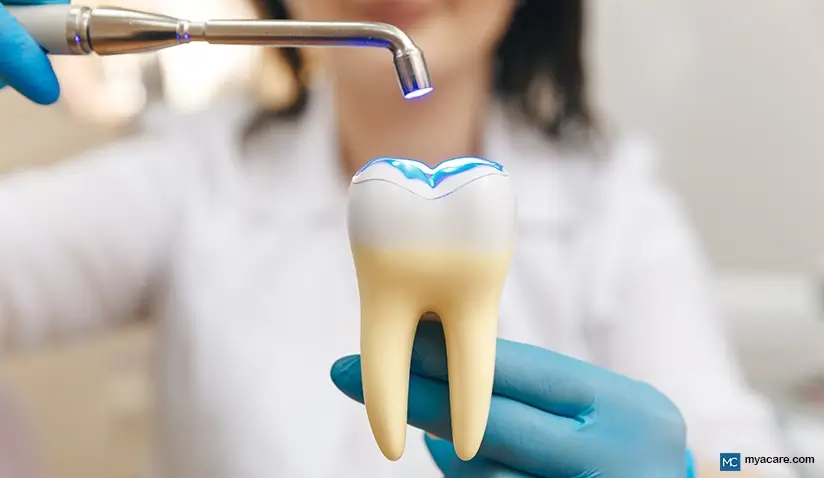What Is Tooth Filling and What Are the Different Dental Filling Options?

A tooth filling is a procedure that involves removing the decayed areas of the tooth and restoring them with a filling material. Usually, a dentist will decide which materials are good for you based on factors such as the size and location of the cavity.
Besides, cosmetic requirements, material's durability, insurance coverage, and the uncovered cost involved are some factors that you may consider before the treatment. Therefore, knowing which filling material is right for you is essential
In this article, we discuss different dental filling options available to you.
What are the Different Dental Filling Options?
Dental filling options can be mainly classified as either metal fillings and tooth-colored fillings.
Metal fillings were popular in the 1900s and 2000s. However, with the rising demand for dental aesthetics, the use of metal fillings has declined in favor of tooth-colored fillings.
Metal fillings: Dental amalgam (silver) filling is the most common type used among metal fillings. Gold fillings were popular in the past and are seldom used these days. However, many dentists still offer traditional gold fillings. More details of these fillings are given below:
a. Dental amalgam filling: Dental amalgam fillings (also known as silver-colored fillings) were commonly used in the 1990s. This silver filling combines liquid mercury and powdered metals such as silver, tin, zinc, and copper. This filling is considered a safe and durable restorative material. In addition, research suggests that amalgam fillings have higher longevity than tooth-colored fillings.
Advantages:
- A dental amalgam filling is relatively inexpensive. For instance, the cost of a silver filling for one or two surfaces is 50-150 USD.
- The amalgam filling is strong and durable and can last an average duration of 10-15 years.
- These fillings are resistant to forces generated while chewing food. So, they are used to fill large cavities, especially in the back teeth.
- Amalgam sets quickly after filling. So, it can be used to restore cavities that are below the gum line where it is difficult to maintain the dry area during fillings.
- It requires less time to fill the cavities. Hence, it is also useful for children with special needs who may find it difficult to stay still for a long time.
Disadvantages:
- Amalgam filling does not stick to the tooth surface. So, to hold the amalgam filling, more healthy tooth structures need to be cut.
- The amalgam filling is aesthetically unpleasing as it is gray and shows up when the individual talks or laughs.
- People may experience temporary sensitivity as metal present in amalgam filling can conduct hot and cold temperatures.
- In rare cases, people with amalgam fillings have reported side effects such as lichen planus (white patches with painful sores in the mouth and skin) or allergic reactions which affect the inner soft tissue skin inside the mouth.
b. Gold fillings: Gold fillings are the oldest fillings used in dentistry over the past 1000 years. These fillings are prepared outside the patient’s mouth after measuring the tooth’s cavity. Later, a customized gold filling is glued to the tooth’s cavity. This is known as a gold inlay. It requires two appointments: One to prepare the filling and another to fix it.
Advantages:
- Gold fillings do not break or fracture when properly prepared, displaying high durability and longevity.
- Gold fillings neither become discolored nor corrode the surface of the tooth.
- They maintain soft tissue health.
Disadvantages:
- Gold fillings are not tooth-colored. These fillings are mostly preferred in back teeth, where it is seldom visible. However, it would be visible when people speak or laugh.
- Gold fillings are highly expensive. For instance, gold fillings in the US cost between 300-1,000 USD for one or two surfaces. This is a technique-sensitive procedure and requires a high level of skill.
Tooth-colored fillings:
Composite resin and glass ionomer cement fillings are commonly used tooth-colored fillings. These fillings are called tooth-colored fillings due to their resemblance to tooth color. Similar to dental amalgam, these fillings are directly placed into the tooth cavity after removing decay from the tooth's surface. Research suggests that composite fillings last for 7-10 years. More details about these fillings are given below:
a. Composite resin fillings: These are the most commonly used alternatives to dental amalgam. They are composed of resin (a type of plastic) and a powdered glass filler material. Composite fillings are available in different shades, which can be used to match the adjacent teeth. Composite fillings are placed into the cavity layer by layer and light cured. Light curing is a process in which blue light is focused on the composite, which hardens the material.
Advantages:
- Composite fillings are available in different shades, which blend with the surrounding teeth and impart a natural look.
- Placement of composite fillings requires the minimal removal of tooth structure as composites bond well to the tooth surface.
- These fillings can be placed in a single visit.
- They are strong and durable and do not corrode.
- These fillings do not require frequent repairs.
Disadvantages:
- The presence of moisture during composite fillings hampers its bonding to the tooth surface.
- Sometimes composite fillings are difficult to remove due to their resemblance to tooth color. This may often lead to the removal of sound tooth structure as well.
- Sensitivity in the tooth may be experienced post-filling.
- These fillings tend to wear or fracture on heavy chewing and grinding.
- Higher cost of placement than amalgam fillings. For instance, composite fillings cost about 90-250 USD for one or more surfaces, whereas amalgam (metal) filling on one or two surfaces can cost 50-150 USD.
Glass ionomer cement fillings:
Like composites, glass ionomer cement (GIC) is a tooth-colored filling used to restore cavities. GIC contains zinc oxide, organic acids such as eugenol, and some resins. This cement is more suitable for small cavities and releases fluoride on placement. GIC hardens on its own after placing into the cavity. Unlike composite fillings, GIC does not require blue light to set.
Advantages:
- GIC fillings are aesthetically pleasing.
- Glass ionomer cement sticks well to the tooth surface. So, minimal amount of healthy tooth structure is removed to place the filling.
- The release of fluoride helps against the development of secondary decay.
- The filling is placed in a single visit.
- The patient may not experience tooth sensitivity post filling.
Disadvantages:
- These fillings are not suitable for larger restorations.
- They tend to fracture or wear in the event of heavy chewing. So, they are not recommended on the biting surfaces of permanent teeth.
- The cost of fillings is higher than amalgam fillings.
Temporary fillings:
A temporary filling is placed in a tooth for a short duration. It may be placed in one of the dental visits and later replaced with a permanent filling in the next dental appointment. These are mostly placed in situations where the same tooth needs multiple appointments, especially during root canal treatment, situations where time is insufficient to complete the procedure, or during dental emergency treatment. Zinc phosphate or glass ionomer cement are commonly used as temporary fillings.
What are the Things to Consider After Tooth Filling?
Here are some of the things to consider after post-filling:
- Mild discomfort or soreness of gums (in case of fillings near the gums) is common post filling.
- Over-the-counter painkillers may be recommended to enhance the comfort levels post-filling.
- Sensitivity to air, cold, hot food, and beverages may be common after a filling. This may remain for a short time. Avoid consuming hot and cold food and beverages for a week or so.
- Avoid the intake of hard and sticky food for a week or so to reduce the chewing pressure on the filled tooth. (Composite fillings harden immediately, whereas amalgam takes 24 hrs.)
- Some may experience tooth pain after a filling. This could be experienced if the filling is tooth high or close to the pulp (inner vital layer of the tooth).
- Some may feel different while biting after the filling. Usually, patients get used to it within a few days.
- Follow routine oral hygiene practice of brushing and flossing twice daily.
- Consult your dentist immediately in case of severe sensitivity, pain, or discomfort.
To search for the best dentists in Germany, India, Malaysia, Poland, Singapore, Spain, Thailand, Turkey, the UAE, the UK and the USA, please use the Mya Care search engine.
To search for the best healthcare providers worldwide, please use the Mya Care search engine.

Dr. Shilpy Bhandari is an experienced dental surgeon, with specialization in periodontics and implantology. She received her graduate and postgraduate education from Rajiv Gandhi University of Health Sciences in India. Besides her private practice, she enjoys writing on medical topics. She is also interested in evidence-based academic writing and has published several articles in international journals.
References:
Featured Blogs



